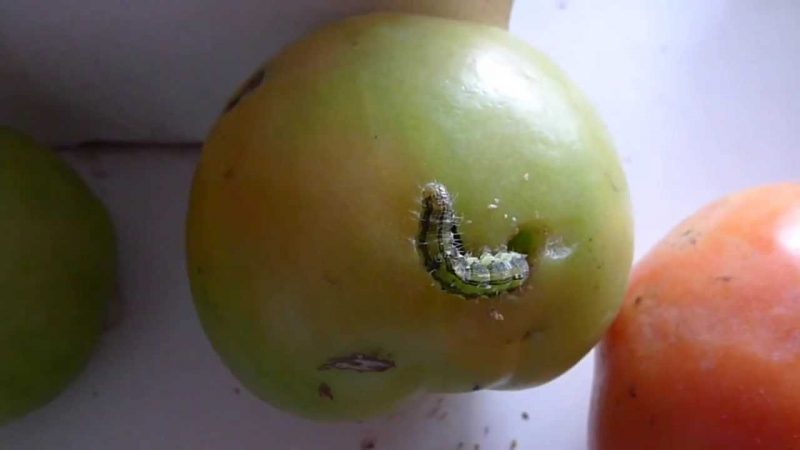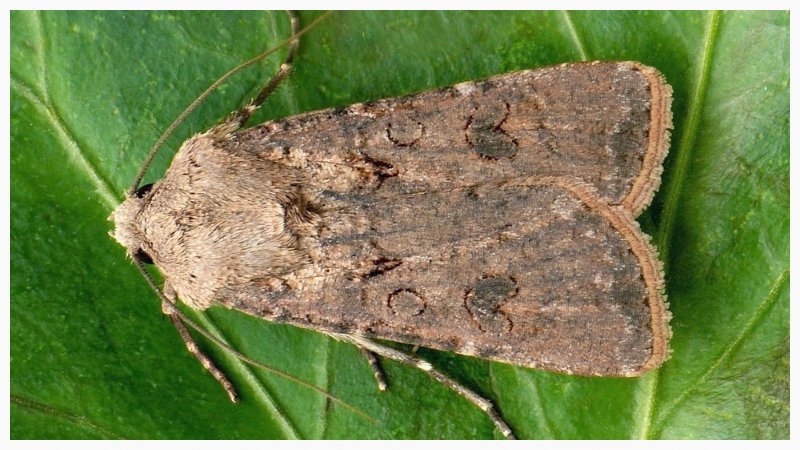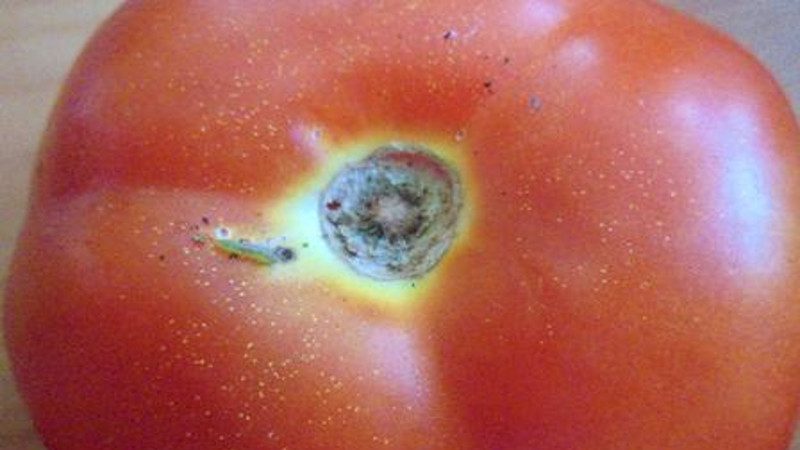We fight pests easily and effectively: how to process wormy tomatoes to save your crop
Tomato pests can destroy crops both outdoors and in greenhouses. Experienced vegetable growers have learned to recognize the types of pests and know how best to eliminate them.
How to save the harvest from a worm, what methods to use when the roots, stems and fruits are damaged, how not to harm the plants at the same time - you will learn about this from our article.
The content of the article
Signs of tomato worm infestation
To determine if tomatoes are wormy or not, examine them carefully. Pay special attention to the cutting, since it is through it that pests most often penetrate into the fruit. If the worms are inside the tomato, you will find small holes that look like tunnels.
Some insects feed on the plant stem. In this case, tissue damage can be seen, possibly the fall of ovaries and flowers.
If the roots are damaged, the plant begins to wither and dries up. It is difficult to recognize the true cause of his death - upon examination, it may seem that the tomato lacked moisture or fertilizer.

What worms can be
It is impossible to detect pests during the day, their phase of activity falls at night. Pests like green fruits more, but some of them feed on roots and stems.
Types of pests:
- scoop;
- click beetle larva or wireworm;
- beetle larva or beetle;
- rootworm nematode.
How to recognize
Caterpillars scoops affect the ground part of the tomato. Adults look like large gray-brown moths with ornamental wings. The caterpillars have a brown, greenish, black color. The insect begins to act in the spring, laying eggs on stems, leaves and ovaries. 3-4 generations of pests can grow in one season.

Some species of scoops feed on stems, leaves and ovaries, while others prefer fruits. They gnaw a hole in the tomato through which they penetrate and completely eat the pulp.
The larvae of the click beetle are called wireworms because of their resemblance to wire. The size of the individual is 10-30 mm, the body is oblong with a yellow color. The pest infects the root system, but sometimes the stems with fruits become its target. The factors provoking its appearance are high humidity and acidity of the soil.
May beetle larvae have a white color, they look like thick caterpillars with a light orange head. The larvae feed exclusively on roots, which is why the plant dies.
Gall nematode is a round worm 1 mm long. It lives in the roots of the plant, which is why thickenings, similar to tubers, appear on them. As a result, the plant begins to lag behind in development, withers and dries up.
A novice gardener may consider that the death of the plant occurred due to a lack of minerals, moisture and fertilizers. You can detect the pest only by digging out the bush and examining the root system.
reference... On the territory of Russia, tomatoes are most often affected by the cotton scoop.
Features of getting rid of worms
When choosing a method of dealing with caterpillars, it is worth considering the characteristics of the plants and the area of damage - an incorrectly selected and incorrectly used tool will not only be useless, but also lead to loss of yield.
In fruits
The fruits in which the caterpillars have taken root are not suitable for food.Pests eat them from the inside, and what remains is subjected to the process of decay.
In stems
It is possible and necessary to fight insects that infect the stems. Some pests gnaw at the tops before fruiting, and then move to the fruit. However, the plant must be treated with caution, given the waiting time for some drugs.
In the roots
Getting rid of caterpillars in the root system of a plant is not easy. Pests can remain in the ground for a long time and infect new plants. Sometimes the appearance of insects on the site is provoked by the gardener himself - when he brings and uses untreated soil or manure in the beds.
Read also:
Why is a cotton scoop on corn dangerous?
Disease and pest resistant tomato variety "Gigant Novikova".
Control methods
Experienced vegetable growers advise using safe folk methods at the beginning of the fight, but if the situation is neglected, biological and chemical preparations will be needed. Agrotechnical techniques will protect against the reappearance of caterpillars.
Biological
In the fight against pests, gardeners often give preference to biological preparations. They are safe, do not contribute to the accumulation of harmful substances in fruits. The principle of action is the use of microorganisms. The remedies are equally effective against all types of caterpillars and worms.
Preparations against pests:
- "Lepidocide";
- "Agravertin";
- "Bitoxibacillin";
- Aktofit;
- Fitoverm.
Chemical
Chemicals are most effective. However, they are used only in cases where other methods have failed.
The following drugs are used against scoops:
- Actellik;
- Iskra M;
- Inta-Vir;
- "Fufanon";
- "Decis";
- "Alatar";
- "Avant".
Remedies for beetle and wireworm larvae:
- "Aktara";
- "Bazudin";
- "Antikhrusch".
There are no chemicals against root gall nematodes, it is extremely difficult to remove the pest from the soil.
Important! Chemical treatment is possible during the growing season, before the fruits are formed on the plant. The waiting period is 20-30 days.
Folk
The experience of gardeners shows that simple and affordable "home" methods can cleanse the area from unwanted insects:
- Hand harvesting of caterpillars - This method is used when the use of chemicals is stopped.
- To scare away insects, the aisles are watered with a solution of ammonia.
- Bleach is used against gall nematodes - it is introduced into the holes before planting seedlings.
- Onion skins or mustard powder protect well from wireworms. The components are added to the well.
- Bait for adults. A plastic cup or bottle is filled with fermented jam, syrup or kvass, and then hung over the beds. The trapped insects are destroyed.
Agrotechnical

Techniques that will allow you to get rid of caterpillars without using drugs:
- planting cruciferous crops, elderberry and lupine around the perimeter of the site;
- mulching the beds with wood chips or needles;
- deep digging of the soil;
- removal of weeds from the garden.
Gall nematode is difficult to remove, but you can get rid of it by planting onions, garlic and calendula next to tomatoes.
Important! You can not leave wormy fruits on the site, they must be destroyed or instilled away from the plantings at a depth of 30 cm.
How to spray tomatoes from worms
The experience of vegetable growers shows that caterpillars are well scared off by infusions of garlic, burdock, calendula, wormwood and tobacco dust:
- Infusion of garlic- chop the head or a bunch of arrows and place in a liter jar. The contents of the container are poured with boiling water and insisted for three days. The infusion is filtered before use. For 10 liters of water, 0.5 glass of infusion is enough. Process in 7-10 days until the complete disappearance of pests.
- Wormwood decoction - Fill a bucket 1/3 with fresh wormwood, add water and simmer for 30 minutes.Then the liquid is infused for two days, filtered and diluted with water in a ratio of 1 to 10. The beds are sprayed with broth 2-3 times a month.
- Infusion of tobacco dust - Dissolve 300 g of dust in a bucket of hot water and leave for 24 hours. The procedure is carried out every 10 days until the disappearance of the caterpillars.
- Salt solution- 100 g of salt is dissolved in 10 l of water, after half an hour the liquid is filtered. The tool is used no more than once a month.
- Infusion of potato tops - 1 kg of fresh stems, pour 10 liters of boiling water. The liquid is infused for one day, filtered before use. The infusion is used every 10 days until the insects disappear completely.
Before use, crushed or melted laundry soap is added to the solution - with it, the products will stick to the leaves of the plant for a long time.
How to properly spray the beds
Treatment against insects is carried out at an air temperature of +20 ° C. For spraying, use a finely dispersed spray bottle. The solution is applied to dry leaves, the liquid should fall on both sides of the leaf and the stem.
If there is no spray bottle, the tomatoes are watered with the solution from above, and then the beds are sprayed with a broom, trying to get the liquid onto the inside of the leaf.
Preventive measures
It is worth taking care of protecting the crop from pests even at the stage of sowing seeds:
- purchase seeds from trusted producers;
- choose varieties that are resistant to pests;
- regularly weed the beds from weeds;
- dig up the ground at the beginning and after the season;
- in the spring, treat the soil with a weak manganese solution or boiling water;
- do not thicken the beds;
- fertilize the beds with mineral fertilizers.
Secrets of experienced gardeners

Pest control is difficult, but there are a few secrets to help fix this problem quickly:
- Manure- the favorite environment of many pests. Caterpillars are attracted to this fertilizer, which increases the risk of introducing pests to their area. If in the past the vegetable grower has already faced the problem of the appearance of worms, it may be worth switching to mineral fertilizers.
- To prevent insects from entering the greenhouse, use mosquito mesh or tulle.
- Frogs- Many vegetable growers deliberately lure amphibians or birds - natural enemies of caterpillars - to their site. This method will not protect against caterpillars infecting fruits and roots.
- In stores for summer residents, predatoryentomophagous insectsare another natural enemies of many pests.
- Raw Vegetable Trap- used against wireworm. A few days before planting seedlings, slices of raw potatoes and carrots strung on sticks are buried on the site. After a couple of days, the sticks are removed along with the insects gathered on the pieces of vegetables.
- Sow white mustard seeds in the beds 2 months before planting the seedlings. When the time comes to plant the tomatoes, dig up the area with the mustard seedlings. Once the transplant is complete, water the seedlings with a mild mustard solution.
- Do not neglect top dressing plants. The victims of caterpillars are often stunted, devoid of strength plants.
Conclusion
Caterpillars are gluttonous and can destroy the entire crop. A grower faced with this problem will have to make an effort not only to drive out pests, but also to protect plants in the new season. Many insects remain in the ground, so you should not neglect preventive measures.
If the precautions did not help, folk methods will come to the rescue. How to process the beds? There are many options - infusions and decoctions of herbs are equally disliked by all types of caterpillars. You can also use biological and chemical preparations, but each gardener must independently assess the need and possible risks from their use.